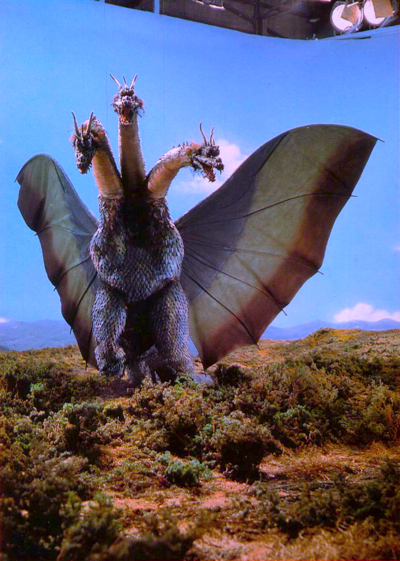
Publicity photoshoot blue color design for King Ghidorah.
GHIDRAH: THE THREE-HEADED MONSTER
San Daikaiju Chikyu Saidai-no Kessen, Toho, 1964, 85 minutes
Director ISHIRO HONDA • Visual Effects Director EIJI TSUBURAYA
"Three Giant Monsters: The Greatest Battle on Earth" (the film's Japanese title) was planned to feature all three of their biggest monster stars, Godzilla, Rodan and Mothra, who would team up to fight a new, and extraterrestrial menace. With the aim to appeal to general audiences, the narrative takes on a fairy tale-style approach, and while it is far more light-hearted than MOTHRA VS. GODZILLA, it rather compliments the Honda-Tsuburaya film that preceded it into theaters, DOGORA: THE SPACE MONSTER (all released the same year), although it features one of the greatest monsters in all cinema.
Shinichi Sekizawa's screenplay is more fantasy-oriented, centering on an Eastern princess (a descendant of aliens) marked for assassination, and written to appeal to a broader audience than the previous films. Honda said to the late Guy Tucker, "When I make a monster film, I never think that it will be for children. I want to imagine and express a story [to a wide audience], but it's always children who are the most interested." While the other monsters are portrayed fairly de rigueur during the most of the film, they suddenly become anthropomorphic, "I don't think that monsters should be comical characters, the audience is more entertained when [the monsters] strike fear in the hearts of the [human] characters." But, despite this, Honda effortlessly sweeps the audience into the story, with assured and swift direction.
Then, there’s the star of the film. Perhaps the most inspired creature the studio ever conceived, King Ghidorah was the idea of scenarist Sekizawa, who only described the monster as having "three heads, two tails, and a metallic roar like a bell." Akira Watanabe, whose sketches combined the mythical Yamata-no-Orochi from Japanese legend and traditional Chinese Dragons, were faithfully brought to life by the prosthetic crew in Toho’s Visual Effects Department, designed the realization of King Ghidorah. According to legend, the triple threat was conceived to be a menacing crimson, while gold was favored by visual effects director, Eiji Tsuburaya. In color publicity photos after the suit was completed, he was painted blue, with red, gold, and blue-striped wings, but it was decided that blue would become problematic with Blue Screen matte process. There've been many conflicting stories concerning this, and no definitive answer, so far. Regardless, the interplanetary invader created such an impact on audiences, that it has since remained one of the most popular monsters ever created by Toho.
Yosuke Natsuki (b.1936), who had just come off of Honda's DOGORA, top-lines the cast as Detective Shindo. A former model, Natsuki, was preened as one of Toho’s new, young leads, and made a number of films in the 1960s. But, he wasn’t a flash-in-the-pan, either, and starred in numerous popular television series, such as G-MEN ’75 (1975-82). Almost twenty years after GHIDRAH, Natsuki returned to the kaiju eiga with Koji Hashimoto’s THE RETURN OF GODZILLA (1984) and more recently in Minoru Kawasaki’s MONSTER X STRIKES BACK: ATTACK THE G-8 SUMMIT (2008) - he also provided the voice of Commander DEUS in ULTRASEVEN X (2007). Still quite active, the veteran actor recently scored important roles in François Rotger’s THE PASSENGER (2005) and Shunichi Nagasaki’s BLACK BELT (2007).
The spunky, and very in-demand, Yuriko Hoshi (WARRING CLANS) stars as Shindo's sister, Naoko, an investigative reporter for a series called "Mysteries of the 20th Century." Ozu regular, Hiroshi Koizumi (DAUGHTERS, WIVES AND A MOTHER), once again plays the scientist, a geologist named "Professor Murai" (both actors seemingly carried over from their similar roles in MOTHRA VS. GODZILLA). The beautiful Akiko Wakabayashi (BANDITS ON THE WIND) plays the unifying character, "Princess Salno," who went on to appear in YOU ONLY LIVE TWICE (1967). Her only starring role was in Luigi Filippo D'Amico’s AKIKO (1961). Originally, the assassin "Malmess" was to be played by actor Yoshio Tsuchiya (FUNERAL PROCESSION OF ROSES), but was held up on the lagging production of Akira Kurosawa's RED BEARD, and was replaced by character actor Hisaya Ito (A WOMAN’S LIFE).
Many of Tsuburaya's visual effects for the picture are thrilling, such as the birth of King Ghidorah, its awesome destruction of Yokohama and Tokyo, and the first battle between Godzilla and Rodan. His work here is as good as seen in MOTHRA VS. GODZILLA - with fantastic long shots of Godzilla and Rodan engaged in mortal combat - until battle reaches the slopes of Mt. Fuji. Here, the scenes between Godzilla and Rodan become static and stagey, oddly juxtaposed with fantastic shots of King Ghidorah’s wonton rampage, until Godzilla, Rodan and Mothra unite to drive off the interloper. The difference is somewhat jarring from the first half of the film, but Tsuburaya believed that this humanizing of the monsters would win over audiences.
Honda said, "I was hesitant to let Mothra act as the mediator... I felt that the monsters... were far too humanized." While the increasing anthropomorphic behavior of the colossi in the last quarter of the film seems to lower the bar that was set with MOTHRA VS. GODZILLA - it still doesn’t lower the entertainment value as a whole. Carried along by Maestro Akira Ifukube's wonderful fairy tale score (including a memorable song from The Peanuts), the visual treats of Tsuburaya, and the magnificence of King Ghidorah, GHIDRAH: THE THREE-HEADED MONSTER (the film's US title), is not only a memorable entry in the series, but also one of the most entertaining films of the kaiju eiga.
Executive Producer TOMOYUKI TANAKA Screenplay SHINICHI SEKIZAWA Production Design TAKEO KITA Cinematography HAJIME KOIZUMI Music AKIRA IFUKUBE Visual Effects Production Design AKIRA WATANABE Visual Effects Photography SADAMASA ARIKAWA [US Version] Additional Music and Sound Effects FILMSCORES INC. English Dialogue JOE BELLUCI Post-production Consultant RAY ANGUS
Starring YOSUKE NATSUKI (Detective Shindo) YURIKO HOSHI (Naoko Shindo) HIROSHI KOIZUMI (Professor Murai) AKIKO WAKABAYASHI (Princess Salno) HISAYA ITO (Malmess) AKIHIKO HIRATA (Chief Detective Okita) THE PEANUTS: EMI and YUMI ITO (The Little Beauties) and TAKASHI SHIMURA (Dr. Tsukamoto)






































10 comments:
great review for a great movie. it was the first Godzilla film i owned- the 8mm comp of "Battle of the Monsters" where the four legged Ghidrah is prominent on the cover, but nowhere in the comp! one of my faves.
David
David,
Thanks, it's one of my favorites as well. I also had a bunch of Super 8mm films from Ken Films — including both 200' reels for GHIDRAH. I used to take footage from some of them and make little clip compilations, inspired by the opening montage for our local "Creature Features" program.
Kids today just have no idea...
Cheers,
August
It's funny -- just a couple weeks ago I got this exact DVD on a lark; I was so blown away that I immediately got the entire boxed set. As a kid, I never really saw any of the Godzilla movies, so this is a journey of discovery for me.
Great review August! I know a resin bag was used to make Godzilla's roar. How was Ghidrah's roar created?
Chris,
It's awesome that you are discovering these films for the first time, and digging them! Hope you're enjoying them, and perhaps, if you'd like to know more about the visual effects director, who might want to purchase a *ahem *certain book currently on the market...
Lee,
Actually, Godzilla's roar was created by rubbing a resin-coated glove down the length of a contrabass string — which was conceived by composer Akira Ifukube. As for King Ghidorah, I have to dig out an interview I have with Toho's Sound Effects Designer from the 1980s... the memories are kind of cloudy on that one.
But, here's a bit of trivia, a modified version of King Ghidorah's roar was used as the telephone ring of the Science Patrol in ULTRAMAN!
Cheers,
August
August,
I have always been a bit fascinated about the whole topic of anthropomorphic nature of the monsters. The quote you cite from Honda clearly shows his hesitence, yet it continued to increase in occurences. To be honest, I really don't mind it at all. I think it is one of the reasons why I find the whole Showa series to be superior to the recent ones. It really does give the G-Films of that period it's charm. I mean come on, how cool is it when Godzilla shakes Jet Jaguar's hand. I dig it everytime I see it.
Keep up the great work! Still lovin' the book!
Tim,
Thanks for the kind comments about the blog and the book, it's really appreciated!
As for Honda's comments... While he stated his reluctance, he also agreed that if Godzilla was the same from film to film, the series would have gotten boring pretty quickly and never lasted as long. So, he agreed that Godzilla had to change to keep audiences coming back.
Remember, Toho didn't consider bringing Godzilla back after GODZILLA RAIDS AGAIN (1955), and produced a whole slew of different monster and science fiction pictures, until John Beck brought them the project which became KING KONG VS. GODZILLA (1962).
Thanks for posting! "Godzilla and Jet Jaguar, will punch, punch, punch!"
Cheers,
August
Chris-
I am in no way on the Ragone payroll and I do not know the guy personally, but speaking as a lifelong lover of Japanese giant monster movies I have to steer you, a newcomer, to his book. Those of us who practically have religion over this stuff are a notoriously tough audience to please, and August's book on Tsuburaya could only be improved by having the power to raise the FX master from the grave, fully restored and once again helming spectacular visions of titanic beasts kicking mankind's ass. Trust me, it's worth every cent.
As for GHIDRAH, I do enjoy it, but I prefer MONSTER ZERO (there's just something to be said for Nick Adams and those Devo-looking aliens). The question over the anthropomorphizing of the monsters always seemed kind of moot to me since it was clear that at least some of the monsters could be communicated with; the most obvious example of this is Mothra and its relationship with the Twin Faeries, so if that could work it wasn't much of stretch for me to accept the creatures acting ways that we could recognize and understand. Plus it was fun for me as a child to be able to get what was going through the heads of the big critters.
Oh, and I have a great story about seeing GHIDRAH on the big screen: back in 1985 my college's film series ran a number of Toho monster epics, and on the night I went to see GHIDRAH my friend Nina and I scored some righteous mushrooms and dosed up just before going to the movie. As the two of us sat there in the dark auditorium we both began to have doubts about whether or not we'd been burned in our mushroom purchase since they were having no effect whatsoever. It turned out we had nothing to worry about; just before the mountain climbers check out the crashed meteor, the film's colors suddenly became a tad more vibrant and a little distorted, and Nina looked at me to ask if I was feeling anything, to which I replied, "Oh, yeeeaaaah...." The fungus then kicked in in earnest, and I got to witness the birth of Ghidrah on the big screen and appreciatively looped on quality hallucinogens. Quite a step up from being eight-years-old and seeing it on THE 4:30 MOVIE, let me tell you!
Bunche,
Thanks for posting! I guess that you experienced GHIDRAH in "Matango-Vision"! What would Ishiro Honda say?
Cheers,
August
great blog! did you happen to find your interview with Eiji Tsuburaya? I've been looking everywhere for how Ghidorah's roar was made!
Post a Comment